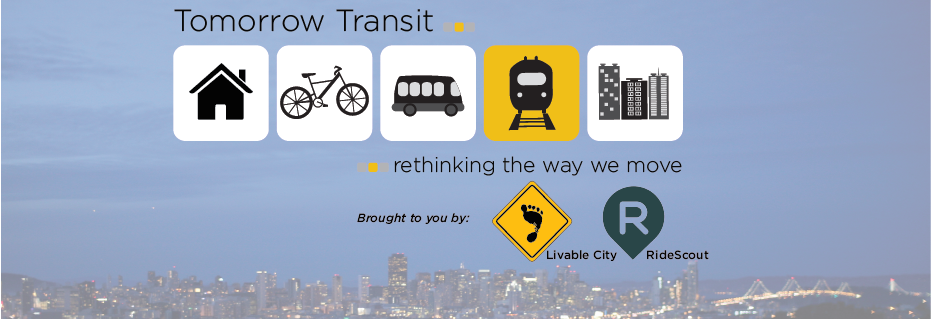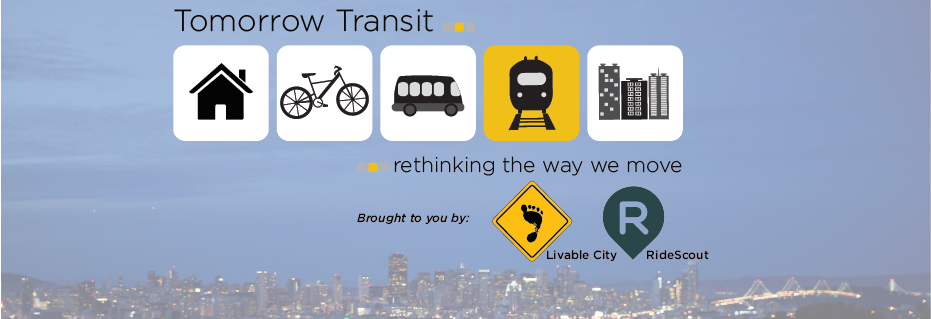Although sprawling, the overwhelming majority of Bay Area residents have convenient access to sustainable modes of transit. A major hurdle for many potential users is the short distance between home and transit, and again between work and transit. These first and last mile challenges keep many people who either live or work in transit poor areas from accessing sustainable transit modes. The Bay Area’s climate – both our mild weather and our reputation for innovation – present many options to create cheap, short-term fixes while implementing long-term infrastructure and land use changes.
We will address these challenges and solutions at Livable City’s Tomorrow Transit: Connecting the Bay to the Last Mile panel discussion on Monday, June 29 from 6:00-7:30. This free event is open to all, and features transportation experts from Bay Area Bike Share, Caltrain, Lyft, and SFMTA’s Taxis and Accessible Services Division.
How can San Francisco and the Bay Area quickly and decisively become a place where walking, cycling, and public transit are the best choices for most trips, and where private auto ownership is unnecessary? Since World War 2, the Bay Area and cities across the U.S. have invested heavily in sprawl development and automobile dependence, along with some significant investments in regional and local transit. The region’s official vision for its future, known as Plan Bay Area, is more compact and transit-oriented, and less automobile-dependent. This planning shift mirrors a large cultural shift, which Alan Ehrenreich calls “the Great Inversion,” which is seeing more Americans favor living in walkable urban neighborhoods.
What we know about travel behavior
Research and data helps us understand how people make transportation choices. They can help guide us to design transportation systems that are both convenient and sustainable – which will make us happier and healthier.
- Walking and cycling can make us happier and healthier. Researchers at the University of East Anglia found that commuters who walked and cycled, even for a portion of their trip, reported increased happiness. Active transportation (cycling and walking) increased happiness more that taking public transit. Even transit riders were happier than commuters who drove alone. Other studies correlate better physical health – including reduced obesity and hypertension – with walking, cycling, and taking public transit rather than driving.
- Wait time weighs heavier. Research has consistently shown that transit commuters weigh the time spent waiting for transit, including waiting to transfer between lines, heavier than time spent on a moving vehicle.
- Transit riders are are generally willing to walk further on the home end of a transit trip than on the work end. A 2004 study of transit-oriented development in California found that a walk of up to half a mile on the home end of the trip made little difference on transit commute rates, but that transit ridership decreased more quickly with distance from the transit stop to work. People are also generally willing to walk further for faster transit.
- Cycling can increase the range of transit. Cycling can increase the convenient distance from home or work to a transit stop up to 2 or 3 miles, where there are safe and direct cycling routes, bike access on transit vehicles, secure bicycle parking, and public bike systems.
- Investments in better walking and cycling around stations increase transit use. The UC Berkeley study found that “creating an attractive, comfortable, and safe walking environment can induce transit riding among station area residents.” Similarly, a well-connected system of walking and cycling paths around transit stations – a small-scale street grid rather than a suburban-style superblocks or cul-de-sacs – increases the reach of transit.
- Information and price are key. Better information – from basics like good signage and real-time schedule displays to more sophisticated tools like moble trip planning tools – orient and empower transit users, and enable them to make the best travel choices. Pricing transportation options to reflect their true costs is also important; employers and cities that subsidize drive-alone commuting actively discourage sustainable transportation choices.
Turning knowledge into action – a strategy for Bay Area mobility
So how can San Francisco and the Bay Area quickly and decisively become a place where active, sustainable modes are the best transportation choices, and where owning a private auto is unnecessary? As the Bay Area approaches transportation gridlock and our global environmental crisis worsens, we must quickly take action to embrace the range of solutions, from immediate, low-cost, and near term, to strategic and long-term plans.
Cities around the world are making increasingly bold strides towards sustainable mobility. Helsinki has set the ambitious goal of making auto ownership obsolete within ten years by integrating existing transit services, bike sharing, taxis, and car sharing and ride sharing services with a comprehensive trip-planning tool and an integrated payment system. Improving streets for walking and cycling, prioritizing transit on roadways, and expanding the regional transit network and improving land-use planning are parts of Helsinki’s comprehensive strategy.
- Use the power of information technology. The proliferation of convenient and reliable trip-planning tools is helping unlock the Bay Area’s transit network, made up of over two dozen often poorly-coordinated transit operators. These trip planning tools can integrate more sustainable modes – bikes, for example – to extend transit’s reach. The region’s next generation Clipper Card should include all the region’s transit operators, as well as bike share, secure bicycle parking, and taxi into a single convenient payment system.
- Safer streets. Walking and cycling are the most sustainable and healthful modes of transportation, but in many parts of the Bay Area are merely an afterthought. Walking and cycling need to be at the center of transportation planning – from transforming the region’s three big downtowns (San Francisco, Oakland, and San Jose) into bikeable and walkable places and growing safe and attractive walking and cycling networks into every Bay Area neighborhood.
- Seamlessly coordinated transit. A seamlessly coordinated transit network – coordinated fares and fare payment, timed and physically connected transfers, and universal information – is essential, and possible even in a region with over two dozen public transit operators. Better schedule and service coordination can create no-wait transfers on a timed-transfer network – between BART and Caltrain at Millbrae, for example, or between feeder bus lines and mainline rail. Doing so would eliminate millions of hours of riders’ wasted transfer time at little or no additional cost. State-of-good repair maintenance and establishing transit priority on city streets improves reliability (essential for timed transfers to work) and reduces transit travel time. Investing in accessible transit – low-floor vehicles, for example – expands mobility for more users.
- Bikes and Transit. Cycling and public transit are a great pairing for sustainable mobility. In the past few years bicycle access to transit has grown, with all-hours BART access and bike racks on more Bay Area buses. There needs to be secure bicycle parking at every station and Bay Area Bike Share pods at every regional transit station and major regional destination.
- Taxis, car-sharing, and ride-sharing. Shared cars and shared rides serve an important role in transitioning from a transit system based on private autos to a sustainable transporation future. Taxis and paratransit provide essential mobility for folks who can’t use fixed-route transit for some or all trips. Making car-sharing ubiquitous in urban neighboroods has been shown to decrease car ownership, which reduces household travel costs, reduces miles travelled, and liberates space in buildings, yards, and public right’s of way from car parking.
- Get smarter about parking. In most of the Bay Area, parking is over-provided and under-priced, generating traffic congestion, degrading the environment, occupying valuable urban space, and requiring vast public and private subsidy for land, construction, and maintenance. Reforming parking requirements, as San Francisco has done over the past decade, and pricing parking to reflect its true costs, will advance sustainable mobility and liberate vast societal resources for other pressing priorities, like public transit and housing.
- Strategic investments in Transit. The region needs to invest more in transit, and invest smarter. The planned Caltrain electrification and modernization of Caltrain will transform it from commuter rail to a regional metro connecting the region’s two largest cities, primary airport, and dozens of cities and jobs centers in between. Extending Caltrain to Downtown San Francisco will serve the the region’s largest concentration of jobs, and connect Caltrain and planned High Speed Rail to BART and dozens of Muni lines. As we add jobs and housing in the region’s urban core, we need to make long-neglected investments in BART and Muni capacity and reliability. We also need to expand Muni’s rail and bus rapid transit network within San Francisco.
- Getting land use right. Land use policies across the Bay Area should focus new jobs within walking distance of regional transit. Restrictions on residential density and mix of uses in transit-rich areas must be relaxed to allow new housing, and the neighborhood-serving shops and services that make neighborhoods walkable. Recent studies show that such compact neighborhoods generate far less auto traffic than planners predict. Reducing parking requirements near transit further decreases auto traffic, increases transit use, reduces development costs and impacts on the environment, and frees ground-floor building space for active street-facing uses. Stronger urban design standards for buildings, streets, and public spaces is essential to creating livable and walkalble places.
To bring about long-term, sustained change, we need local and regional leadership to adopt a shared land use vision. This includes creating walkable communities that are close to jobs and services, major infrastructure projects, and coordination within and between transportation agencies to facilitate transfers and routes. Many employers and developers are already on board, creating convenient shuttle services for their employees, developing car-free housing and transit-oriented developments. Some of these major projects eliminate first/last mile issues altogether: by bringing Caltrain into the Transbay Terminal, regional travelers can step out of the terminal and into their homes or offices. Simple changes, like expanding SFPark’s dynamic meter pricing across San Francisco every day, helps reduce unnecessary trips and car storage. Parking reform can help push single-occupancy drivers into ride-share, car-share, taxis, and public transit. By eliminating the gaps in first and last mile, we can dramatically reduce the Bay Area’s impact on the environment, deliver healthier, happier residents to their destinations, and create a transportation network that can grow and adapt with our region.
Please join us on Monday, June 29 from 6:00-7:30 for a lively discussion about solving our region’s first and last mile issues.






